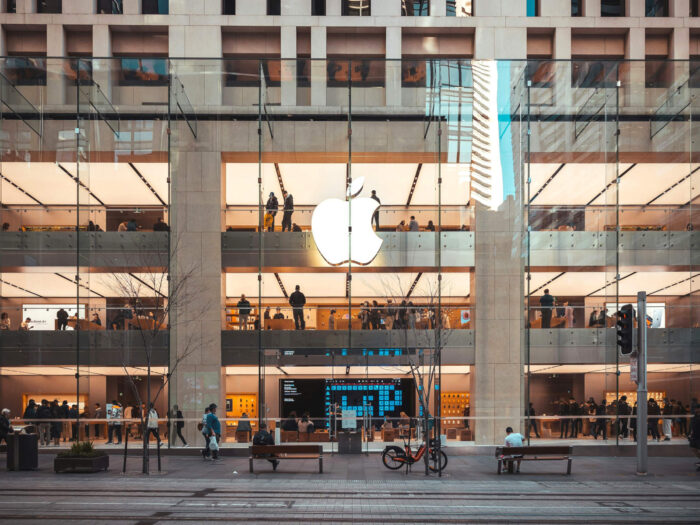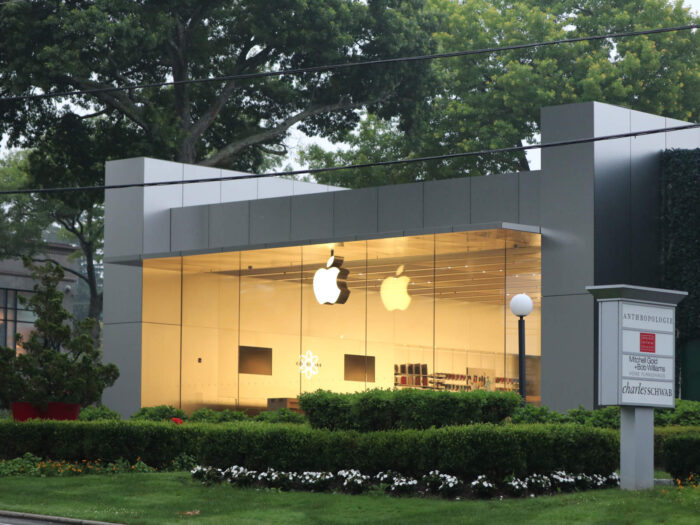
Apple’s marketing mix (4P) targets markets for information technology, consumer electronics, digital content, and online services. The 4Ps (product, price, place, promotion) strengthen strategies for Apple’s mission and vision and goals specific to the technological nature of the business.
Apple’s 4P considers competition with IT and consumer electronics firms, like Google (Alphabet), Samsung, Microsoft, and Sony, as well as video-streaming service providers competing with Apple TV Plus, such as Netflix, Disney, Amazon, and Facebook (Meta). Even IBM and Intel affect Apple’s marketing strategy and marketing mix decisions.
Apple’s Products
This element of Apple’s marketing mix refers to goods and services (business outputs). The company’s product mix includes the IT and related products in this 4P element. Apple’s products are as follows:
- Consumer electronics (iPhone, Mac, iPad, Home, wearables, accessories)
- Advertising
- AppleCare
- Cloud Services
- Digital Content
- Payment Services
The first item in the list above indicates the significance of tangible goods in Apple’s marketing mix and its implementation in the consumer electronics market. Consumer electronics are a core component around which the company’s digital services and other marketing mix elements are developed.
The Mac product line includes desktop and laptop computers of various sizes and specifications for target customers in different market segments. The iPhone, iPad, and other goods, like wearables (e.g., Apple Watch), are devices that function alongside the other products in the product mix.
AppleCare provides limited warranty and technical support available upon purchasing the company’s consumer electronics products. Customers can pay for AppleCare coverage that goes beyond the standard warranty period.
The rest of the product mix shows that Apple’s 4Ps also apply to the online services market. The company’s advertising services are mainly within the App Store. For example, mobile app developers can advertise on the App Store to promote their apps to users.
Regarding Cloud Services, iCloud is available as online storage especially designed for Apple products, like MacBooks and iPhones, although non-Apple devices can also access this online service.
Furthermore, the Digital Content product line (e.g., digital music, videos, e-books, and mobile apps) and Payment Services (e.g., Apple Pay) are easily accessible through various consumer electronics.
The intersections among Apple’s goods and services in this marketing mix create an ecosystem that makes these products attractive to customers. Such an ecosystem supports Apple’s generic strategy for competitive advantage and intensive strategies for growth. Considering these strategies, the product lines in this 4P element are based on the technological outputs of the company’s product-development strategy.
The product lines in this marketing mix relate to human resources and business processes linked to product-based divisions, which are a characteristic of Apple’s organizational structure (business structure).
Also, this element of the marketing mix reflects Apple’s evolution from a computer technology business into an increasingly diversified business with strategic management focusing on information technology.
Place in Apple’s Marketing Mix
This 4P element involves places or venues through which Apple distributes its products in target markets. The following places are included in the distribution strategy applied through Apple’s marketing mix:
- Apple Store locations
- Company-owned websites and online stores
- Authorized resellers
- Telecommunications companies
Apple Store is a subsidiary that operates physical or brick-and-mortar stores that sell the company’s products, along with related products from other manufacturers. For example, these stores sell MacBooks, as well as peripheral devices from other companies.
In this marketing mix, Apple Stores are arguably the most visible and easily recognizable locations that carry the company’s brand. Thus, these stores also promote the Apple brand and are a part of the company’s overall branding strategy.
Customers can also buy products through Apple’s websites and online stores (e.g., App Store) for desktop and mobile. These online distribution channels help the company optimize its international market reach.
Apple’s marketing mix includes authorized resellers as part of the distribution strategy. These resellers operate stores that offer Apple’s consumer electronics and accessories in various strategic locations, such as shopping areas in different markets around the world.
Resellers include large retailers, like Walmart and Target, and consumer electronics retailers, like Best Buy, as well as smaller regional or local ones. Some authorized resellers sell through their own stores as well as their seller accounts on Amazon. Authorized resellers enable Apple’s 4Ps to maintain an extensive multinational network for reaching target customers.
Moreover, this element of Apple’s marketing mix uses agreements with various telecommunications companies, such as Verizon, AT&T, and T-Mobile, which offer iPhone units integrated into some of their service plans available to subscribers in local or regional target markets.
The location strategy in Apple’s operations management supports this element of the company’s marketing mix in taking advantage of online and non-online distribution channels to reach target markets.

Apple’s Promotion
Referring to the promotional mix or the promotional subset of the marketing communications mix, this element of Apple’s marketing mix determines communication tactics that promote products to target customers. This 4P element emphasizes the premium brand of the company’s consumer electronics and other products. The following activities are included in Apple’s promotion:
- Advertising
- Personal selling
- Sales promotion
- Public relations
Apple’s marketing mix makes use of advertising through online digital advertising networks and websites, as well as print media. The company has agreements with prominent websites to advertise and promote Apple products.
The business uses personal selling in the form of Apple Store employees who provide product-specific information in the aim of convincing store visitors to make a purchase. Apple’s company culture (work culture) influences human resources and the effectiveness of personal selling.
Also, among the 4Ps, the promotional mix involves sales promotion for Apple products. For example, students and military personnel can buy iPhones and iPads at discounted prices. Sales promotion attract new customers to the Apple ecosystem of goods and services.
Moreover, the company’s marketing mix uses public relations to optimize its corporate image as a leading technology and online services business. For instance, Apple Events, leaks of new product features, press releases, and exclusive interviews are carefully executed to maximize the company’s positive publicity in the market.
Apple’s marketing strategy also involves public-relations initiatives, such as the Community Education Initiative, which aims to improve formal education outcomes, while promoting the business and its products in target markets.
This 4P element actively interacts with target customers and organizations to promote the technology business. These efforts are linked to Apple’s corporate social responsibility (CSR) and ESG strategy for sustainability and other stakeholder interests.
The company uses such communications tactics in this marketing mix in reaching customers worldwide, while supporting social responsibility and corporate citizenship goals. Apple’s promotion adds to brand value and persuades customers to buy the company’s products.
Price in Apple’s 4Ps
This element of the marketing mix sets prices, price points, and price ranges for the company’s consumer electronics, online services, and related products. The following pricing strategies are in Apple’s 4Ps:
- Premium pricing strategy
- Freemium pricing strategy
The premium pricing strategy involves offering Apple products at a premium. In theory, a premium is an amount or value that is applied in addition to the typical or common price. This pricing strategy leads to higher price ranges.
Apple’s marketing mix implements the premium pricing strategy to set high prices for products. For example, iPhones are more expensive than many competing smartphones, resulting in the maximization of profit margins.
Even though the SWOT analysis of Apple Inc. shows that high prices can be considered a weakness, the company utilizes premium pricing in combination with premium branding and creative innovation to ensure profitability and business competitiveness in the market.
This 4P element also uses the freemium pricing strategy, which applies “free” and “premium” pricing combined into a single strategy to make the company’s technology products attractive. This pricing strategy allows customers to try products before paying for more features.
In this freemium pricing case, some of Apple’s products are free, but customers pay to access more advanced or better features. For example, the company offers free 5 GB of iCloud storage. However, to add more storage capacity to their iCloud accounts, customers must pay a recurring fee.
The pricing strategies in Apple’s marketing mix support premium branding and associated product design and development efforts. Considering the resulting profit margins, this marketing mix ensures the company’s business growth and profitability.
References
- Apple Inc. – Apple Events.
- Apple Inc. – Education Initiative.
- Apple Inc. – Education Pricing and Student Discounts.
- Apple Inc. – Find a Store.
- Apple Inc. – Form 10-K.
- Apple Inc. – iCloud Storage Plans and Pricing.
- Apple Inc. – Veterans and Military Purchase Program.
- Morgan, N. A., Menon, A., Jaworski, B. J., & Musarra, G. (2025). Marketing strategy implementation: Why is it so hard? Journal of Business Research, 190, 115231.
- Pitri, T., Firmansyah, I., Rijanto, R., & Firmansyah, D. (2025). The evolving marketing mix in the digital age and customer mix: How does it affect purchase intention? International Journal of Business, Law, and Education, 6(1), 345-361.
- Saini, A., & Rajesh, A. (2024). Optimising performance by fusion of business intelligence and marketing mix in decision making process. International Journal of Management and Decision Making, 23(4), 415-437.
- Satriandra, M. F. A., & Rozi, R. F. (2025, May). Storytelling of Digital Technology and Brand Identity Among Apple and Samsung Advertisements. In Proceeding of International Conference on Social Science and Humanity (Vol. 2, No. 2, pp. 174-202).
- U.S. Department of Commerce – International Trade Administration – Software and Information Technology Industry.
- Uddin, M., Rashid, M. M., Ullah, N., Rahman, M. A., Afreen, F., & Akther, S. (2025). Marketing mix practices: A conceptual analysis. Educational Research (IJMCER), 7(1), 68-82.